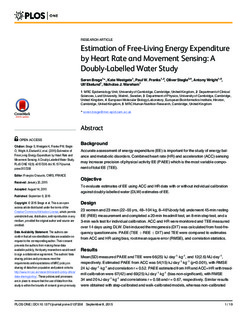| dc.contributor.author | Brage, Søren | |
| dc.contributor.author | Westgate, Kate | |
| dc.contributor.author | Franks, Paul W. | |
| dc.contributor.author | Stegle, Oliver | |
| dc.contributor.author | Wright, Antony | |
| dc.contributor.author | Ekelund, Ulf | |
| dc.contributor.author | Wareham, Nicholas J. | |
| dc.date.accessioned | 2016-04-06T07:29:24Z | |
| dc.date.available | 2016-04-06T07:29:24Z | |
| dc.date.issued | 2015-09-08 | |
| dc.identifier.citation | PLoS ONE. 2015, 10, e0137206 | nb_NO |
| dc.identifier.uri | http://hdl.handle.net/11250/2384097 | |
| dc.description | © 2015 Brage et al. This is an open access article distributed under the terms of the Creative Commons Attribution License, which permits unrestricted use, distribution, and reproduction in any medium, provided the original author and source are credited. | nb_NO |
| dc.description.abstract | Background:
Accurate assessment of energy expenditure (EE) is important for the study of energy balance and metabolic disorders. Combined heart rate (HR) and acceleration (ACC) sensing may increase precision of physical activity EE (PAEE) which is the most variable component of total EE (TEE).
Objective:
To evaluate estimates of EE using ACC and HR data with or without individual calibration against doubly-labelled water (DLW) estimates of EE.
Design:
23 women and 23 men (22–55 yrs, 48–104 kg, 8–46%body fat) underwent 45-min resting EE (REE) measurement and completed a 20-min treadmill test, an 8-min step test, and a 3-min walk test for individual calibration. ACC and HR were monitored and TEE measured over 14 days using DLW. Diet-induced thermogenesis (DIT) was calculated from food-frequency questionnaire. PAEE (TEE ÷ REE ÷ DIT) and TEE were compared to estimates from ACC and HR using bias, root mean square error (RMSE), and correlation statistics.
Results:
Mean(SD) measured PAEE and TEE were 66(25) kJ·day-1·kg-1, and 12(2.6) MJ·day-1, respectively. Estimated PAEE from ACC was 54(15) kJ·day-1·kg-1 (p<0.001), with RMSE 24 kJ·day-1·kg-1 and correlation r = 0.52. PAEE estimated from HR and ACC+HR with treadmill calibration were 67(42) and 69(25) kJ·day-1·kg-1 (bias non-significant), with RMSE 34 and 20 kJ·day-1·kg-1 and correlations r = 0.58 and r = 0.67, respectively. Similar results were obtained with step-calibrated and walk-calibrated models, whereas non-calibrated models were less precise (RMSE: 37 and 24 kJ·day-1·kg-1, r = 0.40 and r = 0.55). TEE models also had high validity, with biases <5%, and correlations r = 0.71 (ACC), r = 0.66–0.76 (HR), and r = 0.76–0.83 (ACC+HR).
Conclusions:
Both accelerometry and heart rate may be used to estimate EE in adult European men and women, with improved precision if combined and if heart rate is individually calibrated | nb_NO |
| dc.language.iso | eng | nb_NO |
| dc.publisher | Public Library of Science | nb_NO |
| dc.subject | bioenergetics | |
| dc.subject | heart rate | |
| dc.subject | energy metabolism | |
| dc.subject | physical activity | |
| dc.subject | accelerometers | |
| dc.subject | fats | |
| dc.subject | urine | |
| dc.subject | adults | |
| dc.title | Estimation of free-living energy expenditure by heart rate and movement sensing: a doubly-labelled water study. | nb_NO |
| dc.type | Journal article | nb_NO |
| dc.type | Peer reviewed | nb_NO |
| dc.subject.nsi | VDP::Mathematics and natural science: 400 | nb_NO |
| dc.subject.nsi | VDP::Mathematics and natural science: 400::Basic biosciences: 470 | nb_NO |
| dc.subject.nsi | VDP::Agriculture and fishery disciplines: 900 | nb_NO |
| dc.subject.nsi | VDP::Agriculture and fishery disciplines: 900::Agriculture disciplines: 910 | nb_NO |
| dc.source.journal | PLoS ONE | nb_NO |
| dc.identifier.doi | 10.1371/journal.pone.0137206 | |
| dc.description.localcode | Seksjon for idrettsmedisinske fag / Department of Sports Medicine | nb_NO |
